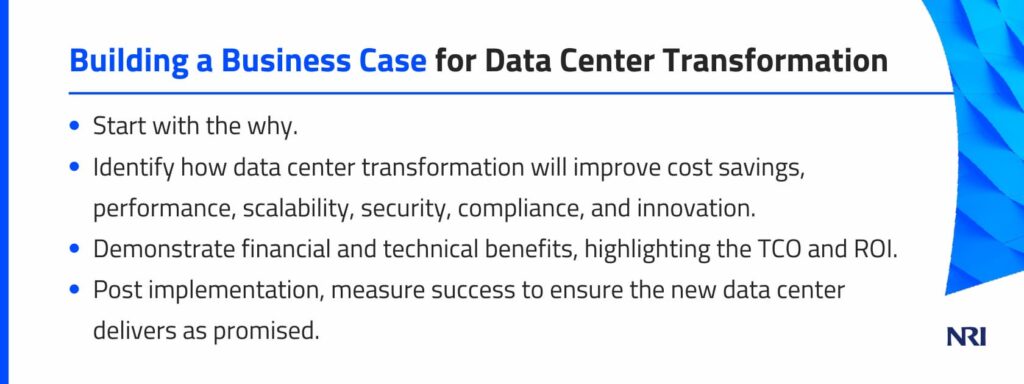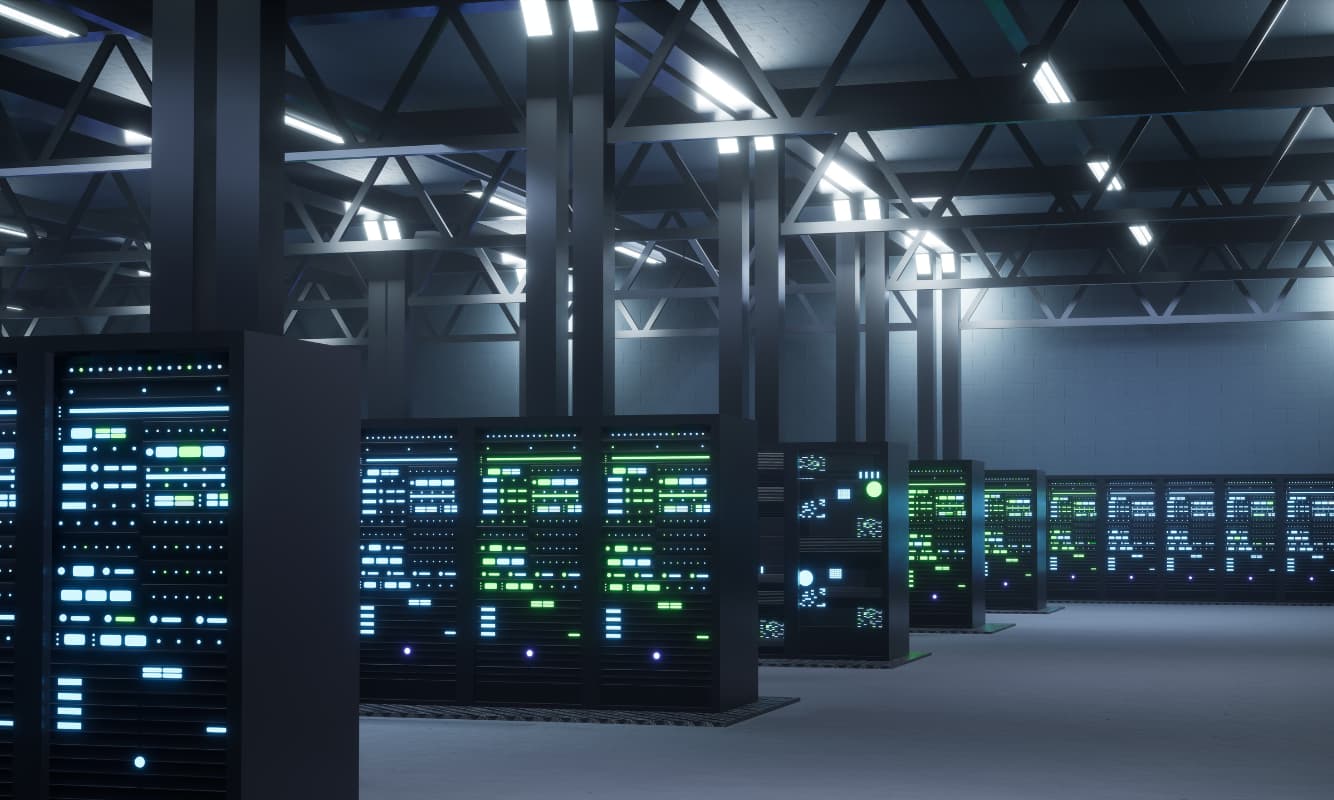Discover how to develop a compelling data center modernization case that resonates with key stakeholders.

Today, businesses expect more value from their IT departments than ever. In addition to solving daily operational challenges, they must define efficient paths to new deployment paradigms, including cloud computing, server virtualization, and software-defined infrastructure. As an IT head, you now face one critical question: how best to lead your organization forward.
While there’s no simple remedy for today’s complex IT challenges, spearheading data center transformation can deliver greater software efficiency, storage, networking, security, and performance while minimizing operating costs. It can help your organization move toward a highly efficient, software-defined infrastructure and leverage the most impactful technologies today and in the future.
Before the transformation initiative can take off, you’ll need to win over key stakeholders. The best way to do this is to steer the conversation toward financial and technology benefits, as stakeholders care most about these. In other words, how will the project lead to better cost savings, performance, scalability, security, and compliance?
In this guide, you’ll learn how to develop and present a clear and compelling business case for data center transformation that resonates with stakeholders. Let’s start.
First, Identify Key Drivers
Start with the why. Identify the main reasons for the data center transformation. These may include:
- Aging equipment
- Inefficient power consumption and cooling capacity
- High operational costs
- Security and compliance
- Compatibility issues
One reason to consider modernization is if your data center’s core electrical and mechanical components have deteriorated, become less reliable, or more costly. An excellent example is if servers perform less work at the same energy levels or require frequent inspection and maintenance.
Similarly, your data center is due an upgrade if the cooling system’s power density can’t cope with the heat generated in your computing environment, leading to frequent overheating and unwanted downtime.
This is a vital driver, considering what’s at stake. Power density requirements change regularly and have doubled over the last decade. Today, a single rack’s density requirement can be as high as 30 kilowatts in high-performance computing environments. That’s all the more reason to upgrade.
Another reason to consider modernization is if the current data center infrastructure doesn’t help meet privacy and security needs. In that case, digital transformation can help avoid breaches, non-compliance fines, and reputational damage. Similarly, upgrading allows you to leverage game-changing innovations and modern applications.
Next, Demonstrate Benefits
No matter what’s driving your data center transformation initiative, demonstrating how upgrades deliver value will be crucial in getting buy-in. Here are some examples:
1. Cost Savings
One of the most compelling arguments for data center transformation is the potential for cost savings. According to VentureBeat, refreshing your data center can reduce the number of servers required by 35%, energy consumption by 29%, and capital expenditures (CAPEX) by 46%.
Given how substantial cost savings can be, including them in your business case is crucial.
The most straightforward approach compares the expenses of running the current hardware and software—including energy, storage, maintenance, service warranties, and replacing expired parts—against those of operating a new environment. This provides a clear picture of the project’s total cost of ownership (TCO) and return on investment (ROI).
2. Enhancing Performance and Scalability
Another crucial aspect to highlight is the potential performance and scalability improvements.
Modern data centers handle increased and new types of workloads, including artificial intelligence (AI). Their enhanced performance allows faster data processing and more effective response to customer needs, improving user experiences and competitive position. Moreover, their fault-tolerant designs improve reliability and uptime.
With cloud integration and virtualization, your organization can quickly scale resources based on real-time demands. This flexibility ensures optimal performance without over-provisioning, resource waste, or cost inflation.
3. Improving Security and Compliance
Data breaches cost businesses an average of $4.88 million in 2024, and stakeholders want to avoid them at all costs. Therefore, it’s essential to demonstrate how new networking and security features align with privacy regulations and compliance requirements and how they will help protect sensitive data against threats.
For example, highlighting how new encryption techniques, access controls, intrusion detection capabilities, and other critical security updates address vulnerabilities and fortify defenses can significantly strengthen your proposal.
4. Supporting Innovation
As you develop your business case, emphasize that data center transformation enables innovation. Through transformation, you can leverage today’s most impactful technologies, such as AI, machine learning (ML), data analytics, and the Internet of Things (IoT).
Embracing these technologies can help derive actionable insights from data, leading to better decision-making and strategic planning. Further, they can streamline workflows within the organization and improve the speed-to-market of new services and products.
Gaining Stakeholder Buy-In
With clarity about how the transformation initiative will improve cost savings, performance, scalability, security, compliance, and innovation, it’s time to present the business case to stakeholders.
Remember, the best approach is to focus on critical metrics like TCO and ROI. For instance, if you can demonstrate that the initiative will reduce operational costs by a certain percentage over, let’s say, five years, that’s a powerful argument for investment.
Additionally, engaging in cross-functional conversations is essential to uncover line-of-business (LOB) needs. Understanding colleagues’ perspectives across the enterprise can help develop strategic and insightful data center optimization plans.
Measure and Communicate Success
Once the transformation initiative is underway, measuring and communicating its success is crucial. Use these metrics to track progress and demonstrate tangible benefits of the investment.
- Power Usage Effectiveness (PUE): Compare total facility energy usage to the energy used by IT equipment to determine the data center’s efficiency.
- Availability: Track the ratio of actual storage uptime against desired or planned storage uptime to determine the data center’s reliability and performance.
- Utilization: Compare used storage versus total storage capacity to ensure no waste.
- Response Time: Measure how quickly the data center responds to queries or requests.
- Capacity: Monitor the availability of power, cooling, and connectivity resources and the amount of additional IT equipment you can effectively deploy without overloading existing infrastructure.
- Costs saved: Count the actual savings realized through the transformation.
Remember to update stakeholders regularly. Effectively communicating achievements builds transparency and credibility and helps you win support for future modernization efforts.
Final words
Data center transformation isn’t just a technical upgrade; it’s a strategic imperative. It ensures your organization remains agile, secure, and ready for growth.
Understanding key drivers and how modernization improves cost savings, performance, scalability, security, compliance, and innovation can help you build a strong business case and secure stakeholder buy-in.
Learn more about simplifying your infrastructure with data center transformation with expertise from NRI.



